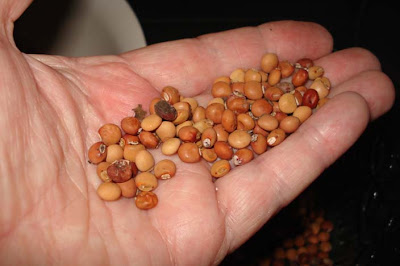I've been slowly sorting through the vegetable seeds I have here - those saved from my own garden and those bought from places like Green Harvest and Eden Seeds. I now have a list of the vegetables we'll grow this season, I don't have all the seeds yet, and some of the seeds I have I'm not sure of. If you're not sure of your seeds, it's best to test the viability of them before you plant. There is nothing more frustrating than planting rows and rows of seeds that never germinate.
There's a simple and old-fashioned way to test for viability. Recently I tested several packs of seeds that were over their use by dates or were saved seeds that I'd forgotten to write a date on. I threw some out as they didn't pass the test and some had a slow and patchy germination rate, so I threw those out too because I want strong and healthy seeds. However, there were quite a few packs that had a very good germination rate, even though some of them were over their use by dates. It pays to check.
This is how to check old seeds for freshness and to see if they will germinate and grow in your garden.
- Write the name of the seed and the date on a piece of paper towel or paper napkin (this is a good way to use up your old stock if you're now using fabric napkins in place of paper towels). You'll need a separate piece of paper for each lot of seeds you're testing. Eight lots of seeds - eight pieces of paper towel.
- Moisten the paper towel. It needs to be moist, not wet.
- Sprinkle about 10 seeds onto the surface of the towel and roll it into a loose cigar shape. The seeds should be inside the towel and firmly held by the paper.
- Get a large plastic bag - and old plastic shopping bag would suit very well - and place all your rolled up paper towels in the bag.
- Gently twist the top of the bag so it keeps the humidity inside the bag and place the bag in a warmish spot, like on top of the TV or near the stove. You want to provide warmth, not heat.
- Leave for four days.
- On the fifth day carefully unwrap the bag and check each roll. If they haven't germinated, reroll the paper carefully and place it back in the bag. If they have started to germinate, mark that roll so you know it's already start germinating.
- Check the rolls every day now, but be careful not to dislodge any seeds.
- Now you have to use your common sense. If, after a period of a week or so, no seeds in a particular roll have shown any signs of life, Google the germination time of that seed and if that time has passed with no signs of life, those seeds are probably dead. Some seeds like parsley and carrots take longer to germinate so make sure you check the germination time for the seeds you're testing. If the germination time has passed and less than half have germinated, the seeds have a low germination rate and are probably not worth planting, but you be the judge about whether you want to try them or throw them on the compost heap.
Germination guide for some popular vegetable seeds.
If you need to buy new seeds this year, try to find heirloom or open pollinated seeds. These are the old-fashioned seeds that have been passed down through the ages and not modified in any way by seeds companies. If you see "F1" on the package, those seeds have been modified. Here is a good explanation of heirloom and F1 seeds from the Gardening Australia site:
"Heirloom varieties of vegetables usually predate World War 2. They are open pollinated, which means that you can save the seed from year to year and from generation to generation. Heirloom varieties have been bred in the first place for flavour, and then for other qualities such as growing well in short summers, or dry summers, or wet summers or long winters etc., so they are much more useful for the home gardener. By contrast modern F1 hybrids are bred for qualities like their ability to be harvested by machine, their ability to withstand the transporting process over long distances and their ability to be refrigerated. They are bred for qualities that give them longevity in the processes before and during their life in the consumer market place. They are in fact bred for almost everything except flavour. The other disadvantage of F1 hybrids is that you can’t save the seed from generation to generation. Gardeners can’t save their own seed at home, and neither can farmers who have to go back to seed companies year after year. Allowing these heirloom varieties to set seed enables the seed to be collected and distributed, ensuring that it has a wide dispersal and so preserving them for future generations. Heirloom varieties have good disease resistance and the yields are often higher than the F1 counterparts. Hybrids are often bred so that they crop all at once so that they can be harvested by machine efficiently, whereas heirloom varieties crop over a longer season making them much more beneficial to home gardeners because it means that they won’t get a glut of fruit or vegetables all at once."
This link has a list of the average time various vegetable seeds remain viable.
How to save seeds.
Heirloom seeds - USA
Heirloom seeds - UK
List of heirloom tomato types
List of tomatoes - Australia
American seed site
Happy gardening everyone!




